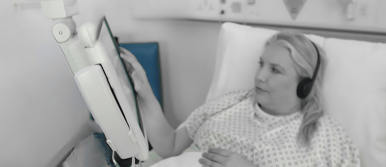WiFi SPARK is helping the NHS achieve its goal of rolling out virtual meal ordering by 2022
6 minute read | 13/09/2021

“NHS hospitals will be required to implement digital menus by 2022 under recommendations in a review of hospital food led by Great British Bake Off star Prue Leith.” - A headline published by Digital Health in October of 2020 reads.
The NHS consistently sees a monetary loss year on year in food wastage. The independent review, which sought to improve the safety and nutrition of hospital food, found that innovative technology has a large role to play in aiding patients to maintain a nutritional diet that manages dietary requirements and allergies whilst in hospital. With the review accelerating the need for change, patient engagement platform provider WiFi SPARK has teamed up with hospital catering innovators Datasym to make the transition as easy as possible.
So, what’s the problem with the way things are now?
At present, when patients order meals in hospital it is done by filling out a paper menu request. The menu contains limited information and does not display meals for specific dietary requirements, instead, this is to be articulated when ordering. Once the order has been decided, ward staff collect the paper and issue it to the hospital’s kitchen staff, who will begin preparing the order and the meal will be delivered to the bed location noted by the patient.
The current system does not account for changes in circumstance such as patient discharge, the relocation of a patient, or changes in dietary requirements, for example, if a patient needs to go into surgery earlier than expected, they will no longer need their meal. Any one of these changes results in wasted food. With the current meal ordering system, the NHS sees a £200m loss on un-eaten food per year, an exorbitant amount that is much better spent on patient care.
With the narrow variety of food on offer through pen and paper ordering sparking questions on the food’s nutritional value, teamed with a gross financial loss year on year, the NHS is committed to revitalising meal ordering through digital adoption across the coming two years.
Technology that is here to help
WiFi SPARK is the proud owner of the SPARK® Platform. Working across over 80 NHS Trusts in the UK, WiFi SPARK is the NHS’ most trusted WiFi solutions provider. Recognising the meal ordering conundrum, the WiFi SPARK team endeavoured to facilitate the move to digital meal ordering through its own SPARK® Media platform.
A managed patient engagement platform, SPARK® Media hosts patient entertainment, educational links, site-specific NHS charity information and now digital meal ordering. All available via any device with a WiFi connection.
Collaborating, at present, with digital catering giants Datasym, the two merged offerings to allow patients easy access to Datasym’s digital meal ordering platform, through a tab on the SPARK® Media homepage. WiFi SPARK aims to be able to integrate with a wider variety of digital catering platforms as time progresses to ensure that the solution is applicable to any Trust.
“...it allows the menu to be changed as often as we like without worrying about the printing costs of menu cards. We can add special diets to the database instantly giving the patients more choice... wastage can now be recorded as well as other useful reports collected that assist the catering department when completing ERIC figures.”
- Tracy Potter, Catering Manager at Southport Hospital noting the brilliance of Datasym’s system in application.
By simply filling out a digital form from their smartphone, tablet or laptop, patients enter their name and bed number and are taken to the digital menu. Being able to explore at their leisure, patients can select their dietary requirements from an extensive list including vegan, kosher, halal, dairy-free, gluten-free, and pureed, to name a few. This stage guarantees there is no confusion in the specific requirements of the patient and only shows them food that meets their needs.
By clicking on menu items patients are met with an image of the meal as well as a description of the ingredients, spice level and a list of its nutritional values. This gives patients greater independence in ensuring that their nutritional needs are met at each mealtime. For those who measure their protein, calorie or fat intake, they can regulate each and every meal in a way that would have been impossible using the pen and paper system. Patients can also choose the portion size of their meal, again reducing wastage in uneaten food.
Once the meal has been built, patients can re-read their choices to ensure everything is as they would like it and then confirm those choices and place the order.
If anything changes, patients can cancel or amend their order by simply logging back onto the meal ordering dashboard. There will be a time cut-off, but any changes made before that pre-determined time will be actioned.
By moving to digital meal ordering patients are in a better position to meet the aims of the independent review and understand the nutritional benefits of their food facilitating a balanced diet and healthier recovery, they are offered a greater variety and given a greater amount of independence in being able to order their meals from their own WiFi-enabled device.
As for the NHS, the savings are made in not having to print menus, dedicate staff time to manually delivering order requests to the kitchen and saving money on food wastage by monitoring patient changes and ensuring they are communicated to the kitchen staff; the change will offer only positives to the running of the Trust.
Whilst digital transformation across the NHS may be a long game, adopting digital meal ordering has the ability to be actively running long before the NHS’ 2022 goal. And with it saving the NHS money and improving patient health conditions, there is no time like the present to make the change.
Finding your solution
WiFi SPARK strives to design and deploy a tailored solution that fits your Trust. To understand more about the ease of the patient journey whilst using the digital meal ordering platform, watch an exclusive demo by clicking the button below.
About the author
Rebecca O'Donovan
Becky is the Marketing Director at SPARK TSL, of whom she has worked for since 2012. She is responsible for high-level marketing strategy focusing on lead generation and aiding the vision of the business to ensure business growth.
More articles by the author
Related articles
 Healthcare Industry
Healthcare Industry
Efficient Hospital Patient Engagement Systems Help Everyone
Medical and admin staff have to balance huge workloads. From organising medical records to checking patients ...
 The SPARK Solution
The SPARK Solution
NHS Patients Shouldn’t Pay for Hospital Entertainment
Why Do Patients Have to Pay for Entertainment? To properly answer this question, we need to go back in time. ...
 Healthcare Industry
Healthcare Industry
4 Tips on Budgeting in Healthcare Management
Even with slight increases to the public health budget, NHS staff know how severe the financial pressure is ...


